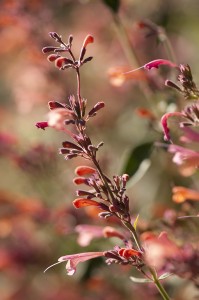Amazing Agastache
Posted in Gardening Tips on September 6 2011, by Sonia Uyterhoeven
 |
Sonia Uyterhoeven is Gardener for Public Education. |

An indispensable addition to any late summer garden is the hummingbird mints (Agastache). They are magnets for butterflies and hummingbirds and generally flower from July well into October.
They are heat tolerant candidates for your garden that thrive in xeric gardens with low fertility. They are in the mint family but are the well-behaved cousin that doesn’t run all over the place. With their fragrant foliage, they are deer and rabbit resistant.
We have several cultivars of Agastache in our Trial Bed Garden in the Home Gardening Center. At the end of the Trial Bed we have a tall upright cultivar called Agastache ‘Heatwave’. It reaches between 3-4 feet tall and has deliciously fragrant blue green foliage. It is covered at this time of year with raspberry colored tubular flowers. Based on its growth habit it is an ideal candidate for the middle of a border.
At the other end of the bed is a more compact hummingbird mint named Agastache ‘Acapulco Salmon & Pink™’. It is part of a popular Acapulco series that come in a variety of colors. As the name suggests it has a pretty blend of salmon and pink flowers. The shape of this hummingbird mint is reminiscent of a catmint (Nepeta) and it sprawls to form a low-growing mound that produces colorful spires of flowers.
My favorite in the bed is an upright, vase-shaped hummingbird mint named Agastache ‘Summer Glow’. It reaches a little over 2 feet tall and is covered from head to toe with pale yellow (almost tan) flowers that are encased in mahogany calyces. This hummingbird mint glows.
If you research the hardiness of these particular hummingbird mints you will find that the information varies. Sometimes they are listed as tender perennials with a hardiness rating of zone 7 to 11 and other times the grower will claim that they survive in zone 6 or even zone 5. If you are trying to grow them as perennials make sure that you provide them with well-drained soil, give them a well-protected or sheltered site, and refrain from cutting them back in the fall (this will give them added protection and prevents moisture from getting down into the crown of the plant).
I am hoping that the hummingbird mints in our Trial Bed will be left to over-winter so I can see whether they are hardy. Our drainage in that area isn’t optimal so it may be cultural conditions and not winter temperatures that lead to their demise.


My bees love it, too.